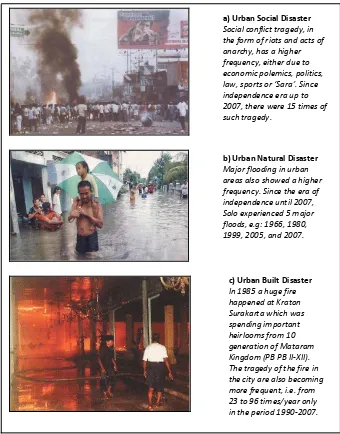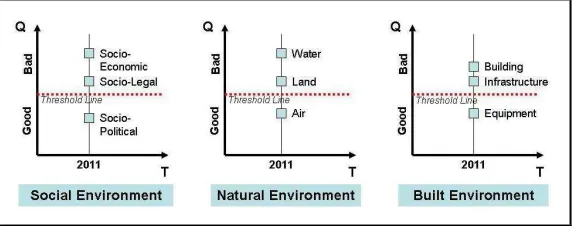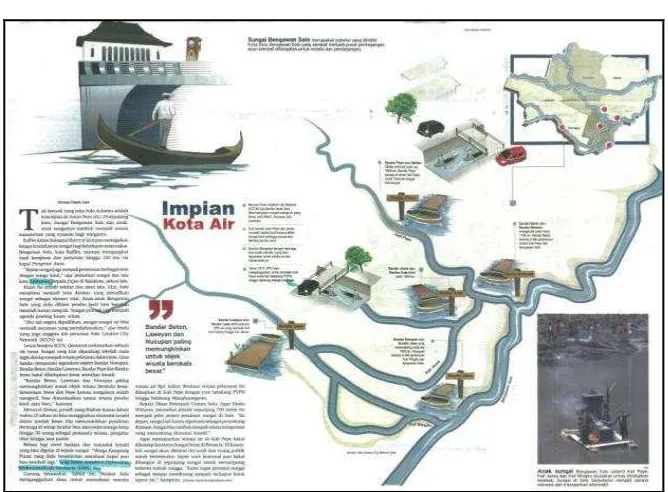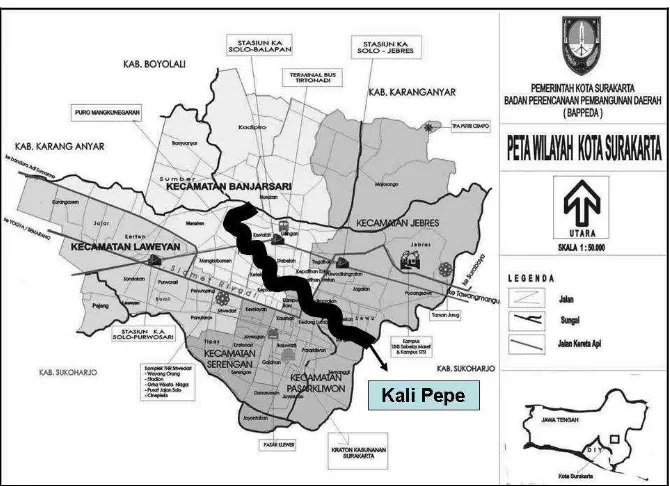Healing the City of Solo by the Javanese-3R:
Resik-Rejo-Rejekeni
Dr. QOMARUN
Associate Professor-Department of Architecture Faculty of Engineering Muhammadiyah University of Surakarta
Head of Urban Design Committee-Solo Creative City Network (SCCN) INDONESIA
ABSTRACT
Entering to the third millennium, the cities in Indonesia are generally plagued by many serious problems, either from the natural environment, built environment or social environment. Sooner or later, these serious problems will finally become an urban disaster, either of urban natural disaster, urban built disaster or urban social disaster. To prevent the more severe disasters in the future, these issues must be covered by the healing. This paper describes the author's practical experience in healing the city of Solo, conducted jointly by the stakeholders, either from the government (Mayor, BAPPEDA, DTRK, BBWS, DPU), the NGO (Ngreksa Lepen, SCCN, YUF), the academics (UNS, UMS, ATMI) or the citizens. Based on the previous research, Solo is more vulnerable from urban social disaster than of urban natural disaster (flood, pollution, landslides) or urban built disaster (fires, collapse, squatter). According to the results of the previous research, there were three main factors causes of urban social disaster: (1) leadership crisis; (2) hypocrite culture; and (3) economic disparity. The concentration of this healing is focused on the last aspect (the economic disparity), since the two other aspects have been successfully carried out by Jokowi as the previous Mayor. The treatment of economic disparity is stepping through the creative economy in the region of ancient rivers in the city of Solo. The efforts of the creative economy in the river region, however, are able to provide a great added value. Therefore, the five main rivers in Solo will be managed with a variety of creative economy efforts. Through the participatory development models with the riversides residents, there was built the concept of Javanese-3R: Resik-Rejo-Rejekeni. The concept of resik (healthy) is to create the river be clean again in the short term (less than 5 years); the concept of rejo (worthy) is to create the river be beneficial in the moderate term (5-10 years); while the concept of rejeke i (wealthy) is to create the river be scene of new jobs for riversides residents in the long term (after 10 years).
Keywords: javanese-3r, solo, urban social disaster, healing the city
INTRODUCTION
the term of sustainable cit (Watson, 2003). The city is not only being able to achieve the sustainability of the natural environment (ecological) and the built environment (technological), but must also being able to cover the sustainability of humanity (socio-economic). Currently, the term of sustainable city has become a strategic object to the various fields of science, such as: Architecture, Urban Design, Urban Planning, Sociology, Ecology, Economics and Geography (Leitmann, 1999; Srinivas, 2008; Moughtin, 2005; Oswald, 2003). The city problems, however, have grown in many aspects of field and been developed to an uncontrollable situation.
Urban space is always related not only by the physical elements, but also by the psychical elements (Bressi, 2001). Physical elements are related to the impact of our health, such as: noise, pollution, exercise, workplaces, housing, healthcare and mobility; while the psychical elements are related to the social and spiritual the most important thing to do in nowadays and the future time. In other words, healing the city is an emergency action in this decade and the next. It explores how to plan and to design of our living environments to keep us sustainable.
THEORITICAL FRAMEWORK
HEALING THE CITY
The term of healing city has developed by the Healing Cities Institute (HCI) in 2010. The institute was founded by Mark Holland, Nicole Moen, Lindsay Clark, Keltie Craig and Joaquin Karakas. Healing city is defined as an integrated approach to planning and design for the natural and built environment that values holistic health and wellness of people and ecosystems (www.healingcities.org, 2014). According to HCI, there are 8 dimensions of healing city: (1) whole communities; (2) conscious mobility; (3) restorative architecture; (4) thriving landscapes; (5) integrated infrastructure; (6) nourishing food systems; (7) supportive society; and (8) healthy prosperity.
The first dimension (whole communities) refers to the awareness that the treatment always involves all of the stakeholders, can not be done alone. The second dimension (conscious mobility) refers to the awareness that the treatment should be able to accelerate the mobility of citizen everyday. The third dimension (restorative architecture) refers to the awareness that the treatment should be addressed to create a comfortable place. The fourth dimension (thriving landscapes) is refers to the awareness that the treatment should be addressed to create a harmonious place (the balance of natural environment and built environment).
URBAN DYNAMICS
Urban dynamics is defined as the growth and development pattern of urban environments during a specific period of time. Urban dynamics refers to the land use change in urban environments in order to provide a historical perspective and an assessment of the spatial patterns, rates, correlation, trends, and impacts of that change. Impulsive model is found in the dynamics of urban development in Solo during 1746-2011 (Qomarun, 2013). This pattern resembles like a random wave rather than a type of arch or curve. This pattern is absolutely different from many models that have been discovered by the experts before, such as: systemic model (Forrester, 1969); evolutionary model (Wilson, 1982), and self-organizing model (Allen, 2005). The main element of urban dynamics in Solo is found in 10 factors, which are nine factors related to decrease quality and one factor related to increase quality. The nine factors are derived from three different aspects.
The first three aspects are the elements from the social environment which then the city has always declined, while the factor that increasing the quality of the city is consciousness collective. So, a nine decreasing factors versus the one increasing factor are the ten factors that lead to the urban dynamics in Solo over the years. Urban Social Disaster (USD) is defined as the intentional event to reduce or even eliminate the city resources, either in the form of human resources, natural resources or man-made resources, due to the natural process of the gap toward equilibrium social environment.
USD ultimately results in the destruction of the built environment, which is named as a mechanism transfo . So, e ha is t a sfo is defined as a process of destruction of symbols, objects or buildings which may represent a specific target of people, institutions or government. USD is essentially the process of energy release due to social stress to achieve social balance. USD can be seen as a battle, burning, killing, robbery, looting, communal clashes, mass rioting, amuck, bombings or terrorism. Solo has experienced 28 times of USD during the 265-year (1746-2011), so that there is a space in the city of Solo often ups and downs. Its typical urban space, which is critical as it is referred above to as a vulnerable space of U“D. Such space above in Solo was detected in the cultural triangle: Kasunanan-Mangkunegaran-Pasar Gede. This region is factually as a symbol of economic-political-cultural activities.
HEALING THE CITY OF SOLO
Solo had a fragile status. The fact showed that the critical condition happen on overall environment, either social environment, natural environment or built environment (see fig. 2).
Figure 2. The Scheme of Urban Quality Status in Solo in 2011 Source: Qomarun, 2013
Based on that scheme, it is seen that the potential urban social disaster (USD) at that time can still be held by only one factor, namely socio-political (leadership). In other words, socio-political status (note: at that time, Jokowi as the Mayor of Solo) can reduce the bad condition of socio-economic and socio-legal. So, the probability of the next communal riot is dependent upon the speed of improvement of socio-economic and socio-legal. The faster the treatment of economic disparity (socio-economic) and cultural hypocrite (socio-legal), the more secure the city of Solo from communal riots. In other words, how to change the socio-economic status and socio-legal status to get a good level is the essence of healing city of Solo. The following are the processes of healing city of Solo as a creative engagement through design praxis during 2012-2014.
1. WHOLE COMMUNITY DIMENSION
Figu e . Pu li atio of “CCN as a Whole Co u it i Heali g Cit of “olo
Source: Qomarun, 2014
2. SUPPORTIVE SOCIETY DIMENSION
Figure 4. Publication to Solopos to Get a “uppo ti e “o iet i Heali g Cit of “olo Source: Solopos, February 16th, 2013
3. HEALTHY PROSPERITY DIMENSION
Figure 5. Kali Pepe ‘i e as Pilot P oje t of Health P ospe it in Healing City of Solo Source: Qomarun, 2014
RESIK-REJO-REJEKENI AS THE DESIGN PRAXIS DIMENSION
Having got many meetings and discussions conducted by SCCN, either in City Hall (Balai Kota), office of sub-district (Kantor Kecamatan), office of village (Kantor Kelurahan), or house of citizens (Rumah Warga), there were many results. The need for space and the building is actually raised by the citizens themselves, while the city government will act as executor. In other words, the standard physical development is to be the domain of government, while the non-standard physical development is becoming public domain. Standard physical developments are including: sediment dredging; city sewers; river channeling; road construction; inspection manufacture; and wastewater treatment plant. Meanwhile, non-standard physical developments are including: communal kitchen; communal drying manufacture; procurement of waste banks; the art hall of riversides; and other creative facilities as a result of the excavation of local potential.
community of Kali Pepe; and bicycle Sunday morning on riverside of Kali Pepe. In the year 2014, the project of sediment dredging is still happened, and will be finished by the end of this year. To know more the process of healing city of Solo at this first step (resik), the followings are the photos during 2013-2014 (see fig. 6-7). Meanwhile, for the next step (rejo-rejekeni) will be arranged in the future time by the community.
Figure 6. Kali Pepe as the Pilot Project of Healing the City of Solo Source: www.solopos.com, 2014
Note:
The various conditions of Kali Pepe as the pilot project of healing city of Solo. The activities of sediment dredging were conducted by the department of public works on headwaters of Kali Pepe (above). The activities of cleaning and sporting had been done
Figure 7. Resik-Rejo-Rejekeni as the Result of CAP in Kali Pepe Development Source: Qomarun, 2014
Note:
The process of Community Action Planning (CAP) is conducted in many places, i.e.: City Hall (above), office of sub-district (middle), office of village (below-left) and house
of Mayor (below-right). The members of CAP are: the government (Mayor, Bappeda, DTRK, BBWS, DPU), the NGO (Ngreksa Lepen, SCCN, YUF), the academics (UNS, UMS,
CONCLUSION
This paper shows about the creative engagement through design praxis. Solo has experienced in many disasters. To prevent the more severe disasters in the future, especially of Urban Social Disaster (USD), city of Solo actually needs many treatments. This paper describes the author's practical experience in healing the city of Solo, conducted jointly by the stakeholders, either from the government (Mayor, Bappeda, DTRK, BBWS, DPU), the NGO (Ngreksa Lepen, SCCN, YUF), the academics (UNS, UMS, ATMI) or the citizens. The concentration of this healing is focused on the aspect of economic disparity. The treatment of economic disparity is stepping through the creative economy in the region of ancient rivers in the city of Solo. The efforts of the creative economy in the river region, however, are able to provide a great added value. The pilot project is chosen on the region of Kali Pepe. Through the participatory development models (CAP) with the riverside residents, there was built the concept of Javanese-3R: Resik-Rejo-Rejekeni. The concept of esik (healthy) is to create the river be clean again in the short term (less than 5 years); the concept of ejo (worthy) is to create the river be beneficial in the moderate term (5-10 years); while the concept of ejeke i (wealthy) is to create the river be scene of new jobs for riverside residents in the long term (after 10 years). This paper suggests that outreach efforts have only increased if there is a start. In other words, although it is very difficult to get started, the public engagement will be increase more and more since there was a beginning.
BIBLIOGRAPHY
ALLEN, Peter, M. (2005) Cities and Regions as Self-Organizing Systems Models of Complexity. London: Taylor & Francis.
BRESSI, Todd W. (2001) Healing Garden. UC Berkeley: Publisher.
FORRESTER, Jay, W. (1969) Urban Dynamics. Massachusetts: MIT Press, Cambridge.
GESLER, Wilbert M. (2003) Healing Places. Rowman & Littlefield Publisher.
HOLLAND, Mark et all. (2010) The Healing Cities Institute.
http://www.healingcities.org. Accessed March 25th, 2014.
LEITMANN, Josef (1999) Sustaining Cities: Environmental Planning and Management in Urban Design. New York: McGraw-Hill.
MOUGHTIN (2005) Urban Design: Green Dimension. New York, Architectural Press.
OSWALD, Franz & Baccini, Peter (2003) Netzstdat: Designing the Urban. Berlin, Birkhauser.
QOMARUN (2013) Dinamika Perkembangan Kota Sala, 1746-2011. Yogyakarta: Disertasi Arsitektur-UGM.
QOMARUN (2014) Pendampingan Panitia Sayembara Penataan Kali Pepe Solo 2013. Surakarta: Laporan Pengabdian Masyarakat UMS.
SOLOPOS (2013) Impian Kota Air. Liputan Khusus Solopos, February 16th, 2013.
SOLOPOS (2014) Kali Pepe. http://www.solopos.com. Accesed April 1st, 2014.
Management. http://www.gdrc.org/uem. Accessed May 2nd, 2011.
UN-HABITAT (2010) Community Action Planning. http://www.unhabitat.org. Accesed April 1st, 2014.
WATSON, Donald (2003) Time Saver Standard for Urban Design. New York: McGraw-Hill.
WILSON (1 E olutio of U a “patial “t u tu es: A ‘e ie of P og ess and ‘esea h P o le s Usi g “IA Models , i Jou al Bulleti of Institute of





